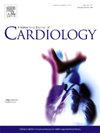收缩储备对TAVI左心室功能障碍患者临床预后的影响。
IF 3.2
2区 医学
Q2 CARDIAC & CARDIOVASCULAR SYSTEMS
引用次数: 0
摘要
目的:主动脉瓣狭窄(AS)和严重左心室(LV)功能障碍患者经导管主动脉瓣植入术(TAVI)后预后较差。关于多巴酚丁胺应激超声心动图(DSE)在患者选择TAVI中的作用的数据有限。我们的目的是研究收缩储备(CR)的预后价值及其与射血分数(EF)恢复的关系。方法和结果:在17个欧洲中心对EF ≤ 30 %接受TAVI的连续患者进行多中心登记。患者根据有无CR进行分组,并根据TAVI后EF恢复情况进一步分层。主要终点为3年死亡率。我们的队列包括296例行DSE的患者,其中158例CR+。中位随访2.4 (IQR 2-3)年后,CR-组和CR+组的3年死亡率分别为43.7% %-vs.34.0 %(调整后HR为1.98,95% % CI[1.21-3.29],p = 0.009)。CR+与低流量低梯度AS无相互作用。在整个队列中,141例(47.6 %)患者EF恢复,其3年死亡率较低(无EF恢复者为29.6 %,无EF恢复者为45.1 %;HR为1.68,95% % CI[1.24-2.97],p )结论:DSE的CR与死亡率降低相关,通过其对EF恢复的影响来调节。我们的研究结果强调了DSE和CR状态在严重AS和LV功能障碍患者分诊中的潜力,并支持其在tavi前评估中的常规应用。本文章由计算机程序翻译,如有差异,请以英文原文为准。

The impact of contractile reserve on clinical outcomes in patients with left ventricular dysfunction undergoing TAVI
Aims
Patients with aortic stenosis (AS) and severe left ventricular (LV) dysfunction, have poor outcomes following transcatheter aortic valve implantation (TAVI). There is limited data regarding the role of dobutamine stress echocardiography (DSE) in patients' selection for TAVI. Our aim was to examine the prognostic value of contractile reserve (CR) and its association with ejection fraction (EF) recovery.
Methods and results
A multicenter registry of consecutive patients with EF ≤ 30 % undergoing TAVI at 17 European centers. Patients were grouped according to those with/without CR, and further stratified by EF recovery post TAVI. The primary endpoint was 3-year mortality. Our cohort included 296 patients who performed DSE, of whom 158 were CR+.
After a median follow-up of 2.4 (IQR 2–3) years, 3-year mortality was 43.7 %-vs.34.0 % in the CR- and CR+ groups, respectively (Adjusted HR 1.98,95 % CI[1.21–3.29],p = 0.009). There was no interaction between CR+ and low-flow low-gradient AS. In the entire cohort, EF recovery occurred in 141 (47.6 %) patients, who experienced lower 3-year mortality (29.6 % vs.45.1 % for those without EF recovery; HR 1.68,95 % CI[1.24–2.97],p < 0.01). Following multivariate adjustment, CR+ was an independent predictor of EF recovery (OR 6.06 95 % CI[3.48–10.53],p < 0.001). Stratified by CR status and EF recovery, 3-year mortality was similar in the different EF recovery groups.
Conclusion
CR on DSE is associated with reduced mortality, mediated through its impact on EF recovery. Our results highlight the potential of DSE and CR status in the triage of patients with severe AS and LV dysfunction, and support its routine use in the pre-TAVI assessment.
求助全文
通过发布文献求助,成功后即可免费获取论文全文。
去求助
来源期刊

International journal of cardiology
医学-心血管系统
CiteScore
6.80
自引率
5.70%
发文量
758
审稿时长
44 days
期刊介绍:
The International Journal of Cardiology is devoted to cardiology in the broadest sense. Both basic research and clinical papers can be submitted. The journal serves the interest of both practicing clinicians and researchers.
In addition to original papers, we are launching a range of new manuscript types, including Consensus and Position Papers, Systematic Reviews, Meta-analyses, and Short communications. Case reports are no longer acceptable. Controversial techniques, issues on health policy and social medicine are discussed and serve as useful tools for encouraging debate.
 求助内容:
求助内容: 应助结果提醒方式:
应助结果提醒方式:


